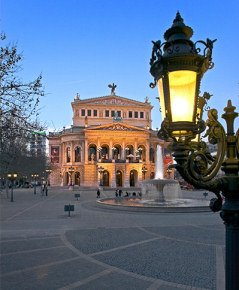CONCERT REVIEW: Frankfurt Radio Symphony Orchestra/Sibelius

Alte Oper, Frankfurt. Home of the Frankfurt Radio Symphony Orchestra.
From Music Web International:
Seen and Heard International Concert Review
Sibelius, 'Kullervo' : Charlotte Hellekant (mezzo) Jorma Hynninen (bar) National Male Chorus of Estonia, hr-Sinfonieorchester (formerly Frankfurt Radio Symphony Orchestra) Paavo Järvi (conductor) Alte Oper, Frankfurt 12.10.2006 (By Brendan Blacker)
Sibelius' early choral symphony, Kullervo, op. 7, was premiered to great critical acclaim in Helsinki in 1892, though its next performance was not until 1958, one year after the composer's death. The piece was not performed in the United States until Kenneth Schermerhorn took the Milwaukee Symphony on an East Coast tour with the piece in 1970. For a piece with such a chequered start to life, Kullervo has finally achieved a place in the standard repertoire with a number of fine recordings recently hitting the shelves, although concert performances are still a fairly rare treat.
One can understand Sibelius' love-hate relationship with this piece, since it contains some of his most beautiful and characteristic writing, while at the same time suffering from quite a few pages of less than brilliant music. The opening theme in the first movement, to take one example, blooms immediately into life, sweeping its way through the strings and brass, only to be cut short in its development by an abrupt gear change. One notices particularly with Sibelius that his skill as a developer of themes was only perfected in his late works, for example in the fifth and seventh symphonies, and in tone poem Tapiola.
Enough about the piece - what of this performance? This event marked Paavo Järvi's inaugural concert as the newly-installed Chief Conductor of hr-thr-Sinfonieorchester. Järvi, although not a tall man, certainly imposes his presence on the orchestra and audience alike. His smooth and rounded gestures are large in compass, but nonetheless are highly clear and articulate. His focus is on both the broad architecture of the music as well as its delicate features. In the first movement, Järvi created the perfect ambience to commence this work, with a pleasant bias towards the brass section of the orchestra, while not permitting any interference with the movement's many delectable string melodies.
The second movement was for me a revelation. The calm ebbing and flowing of the string ostinato that opens the movement was played with such serenity and tenderness it transported me far, far away from Frankfurt. Thoughts of Finland and its snow-covered forests and frozen lakes came easily to mind in this serene lullaby which depicts Kullervo's youth. When the same ostinato is played fortissimo by the brass later in the movement, Järvi gained maximum impact out the excellent brass players. Although both Jorma Panula in his Naxos release, and Paavo Berglund on EMI have produced very fine Kullervo recordings, neither are able to match the atmospheric reading that Järvi achieved in this movement.
The third movement is at the centre of this work, and depicts Kullervo's fiery romance with a woman who later turns out to be his sister! This energetic movement was breathtakingly played by Järvi's forces, and introduced the male chorus with some rousing passages of great impact.
The fourth and fifth movements depict Kullervo at war and Kullervo's death, respectively. These movements feature long passages involving both soloists. It is in these sections that the work breaks down somewhat, with the mood of the score greatly interrupted by long passages of recitative-style singing. Nevertheless, when the orchestral sections return in the last movement, the work gets back on track, and includes an exciting re-appearance of the work's opening theme.
As already noted, the hr-Sinfonieorchester has an excellent, if not superb brass section, with trumpets and horns in particular providing immaculate sound, attack and intonation. The orchestra's strings played with a unity that is rare among European orchestras and the ensemble as a whole was consistently good.
The orchestra was joined for this performance by the National Male Chorus of Estonia and two vocal soloists. The chorus was outstanding in its singleness of voice, its clear intonation and robust and authentically Finnish sound, and largely overshadowed the respectable contributions made by the soloists.
The Alte Oper Frankfurt, despite its classical exterior, is now a modern concert hall, having been resurrected from its war-time ashes in 1981. The ubiquitous wooden panelling and relatively low ceiling help the hall to generate a bright and responsive acoustic, even when sitting in the back rows as I was on this occasion.
In summary, if Järvi's chief conductorship of this orchestra is to be characterised by concerts like this, then a subscription is easily warranted.
Comments